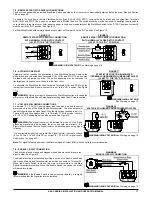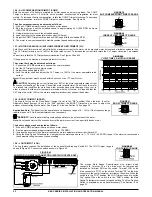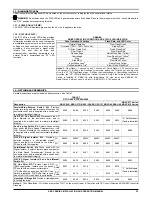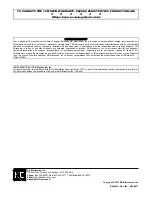
KBAC SERIES INSTALLATION AND OPERATION MANUAL
22
12.6 – SLIP COMPENSATION TRIMPOT (COMP)
Sets the amount of Volts/Hz to maintain set motor speed under varying loads. The COMP
Trimpot is factory set to 1.5 Volts/Hz, which provides excellent speed regulation for most
motors. To increase the slip compensation, rotate the COMP Trimpot clockwise. To decrease
the slip compensation, rotate the COMP Trimpot counterclockwise. See Figure 38.
The slip compensation may be adjusted as follows:
1.
Wire an AC RMS ammeter in series with one motor phase.
2.
Run the motor and set the unloaded speed to approximately 50% (900 RPM on 4-pole
1500/1725 RPM motors).
3.
Using a tachometer, record the unloaded speed.
4
. Load the motor to the nameplate rated current (AC Amps).
5.
Adjust the COMP Trimpot until the loaded RPM is equal to the unloaded RPM.
6.
The motor is now compensated to provide constant speed under varying loads.
12.7 – MOTOR OVERLOAD (I
2
t) WITH RMS CURRENT LIMIT TRIMPOT (CL)*
Sets the current limit (overload), which limits the maximum current to the motor, which prevents motor burnout and eliminates nuisance trips.
The CL Trimpot is factory set to 160% of the drive rated current. To increase the current limit, rotate the CL Trimpot clockwise. To decrease
the
current limit, rotate the CL Trimpot counterclockwise. See Figures 39 and 40.
*
UL approved as an electronic overload protector for motors.
The current limit may be adjusted as follows:
1.
Connect an AC RMS ammeter in series with one motor phase.
2.
Set the CL Trimpot fully counterclockwise.
3.
Adjust the speed setting to 30%.
4.
Lock the motor shaft and adjust the CL Trimpot to 160% of the motor nameplate rated
current.
Note:
This adjustment must be made within 6 seconds or an I
2
t Trip will occur.
CAUTION!
Adjusting the current limit above 160% of the motor nameplate rated current
can cause overheating of the motor. Consult the motor manufacturer. Do not leave the motor
in a locked rotor condition for more than a few seconds since motor damage may occur. In
order to ensure that the motor is properly protected with the I
2
t feature, it is required that the
CL Trimpot be set for 160% of the motor nameplate rated current, as described below.
12.8 – BOOST TRIMPOT (BOOST)
The drive is factory set for Fixed Boost (Jumper J6 set to the "FIX" position). When the drive is set for
Adjustable Boost (Jumper J6 set to the "ADJ" position), the BOOST Trimpot can be used to adjust the
amount of boost voltage to the motor. See Figure 41. Also see Section 10.5 on page 20.
Application Note:
The Boost function operates over a frequency range of 0 – 15 Hz. If the frequency range
required is above 15 Hz, Boost adjustment is not necessary.
WARNING!
To avoid motor winding overheating and failure, do not overboost the motor.
Note:
An unloaded motor with excessive boost will draw more current than a partially loaded motor.
The boost voltage may be adjusted as follows:
1.
Wire an AC RMS ammeter in series with one motor phase.
2.
Run the motor unloaded at approximately 4 Hz (or 120 RPM).
3.
Increase the boost until the ammeter reaches the motor nameplate rated current (Amps AC).
4.
Using the Main Speed Potentiometer, slowly adjust the motor speed over a 1 – 15 Hz (0 – 450 RPM) range. If the motor current exceeds
the nameplate rating, decrease the boost setting.
12.9 – JOG TRIMPOT (JOG)
The Jog feature requires the installation of the optional Run-Stop-Jog Switch Kit. The JOG Trimpot range is
shown in Figure 42. Connect the switch as sown in Figure 43.
The orange Main Speed Potentiometer wire (wiper) which
connects to Terminal P2 on the drive must be removed and
installed on Terminal RUN on the switch. Terminal JOG on the
drive connects to "JOG" on the switch. Terminal "P2" on the drive
connects to the center (common) terminal on the switch. When the
switch is in the "JOG" position, the JOG Trimpot is used to set the
"jog" speed. When the switch is in the "RUN" position, the Main
Speed Potentiometer is used for speed setting. The Run-Stop-Jog
Switch is available as an optional accessory. See Section 14 on
page 23.
FIGURE 38
SLIP COMPENSATION TRIMPOT RANGE
FIGURE 39
CURRENT LIMIT TRIMPOT RANGE
FIGURE 40
I
2
t TRIP TIME VS. MOTOR CURRENT
FIGURE 41
BOOST TRIMPOT RANGE
FIGURE 42
JOG TRIMPOT RANGE
FIGURE 43
RUN-STOP-JOG SWITCH CONNECTION (SPDT WITH CENTER OFF)
*


































